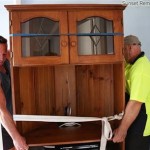Where To Get Rid Of Large Furniture: A Comprehensive Guide
Disposing of large furniture items can be a significant logistical challenge. Whether due to downsizing, redecorating, or simply replacing worn-out pieces, finding responsible and efficient ways to remove unwanted sofas, tables, beds, and other bulky items is crucial. This article provides a detailed overview of various options for furniture disposal, considering factors such as the condition of the furniture, your budget, and your commitment to environmental sustainability.
Donation Options: Giving Furniture a Second Life
One of the most socially responsible methods of furniture disposal is donation. Many charitable organizations and non-profit groups accept gently used furniture, providing it to individuals and families in need. Before attempting to donate, it’s essential to assess the condition of the furniture. Most organizations have specific guidelines regarding acceptable items, and it’s crucial to ensure that the furniture is clean, structurally sound, and free from significant damage or stains. Tears, excessive wear, or pest infestations may disqualify an item from donation.
Organizations like the Salvation Army and Goodwill are well-known for accepting furniture donations. They typically have established donation centers where items can be dropped off. Some locations also offer pick-up services for larger items, although this may be subject to availability and geographical limitations. Habitat for Humanity ReStores are another excellent option. These stores sell donated building materials, appliances, and furniture to the public at discounted prices, using the proceeds to support Habitat's mission of building affordable housing. Local charities specific to your community may also accept furniture donations. These organizations often focus on supporting local families or specific demographics, such as veterans or individuals transitioning out of homelessness. Researching local options allows for direct support to your immediate community.
Prior to donating, it's advisable to contact the organization directly to confirm their current needs and acceptance criteria. Inquiring about any specific requirements for preparing the furniture for donation, such as cleaning or disassembly, is also recommended. Obtaining a receipt for your donation is crucial, as it may be tax-deductible. Remember to document the condition of the furniture with photographs, as this can be helpful for substantiating the value of the donation for tax purposes. Finally, be realistic about the condition of your furniture. Attempting to donate items that are clearly unusable or unsafe can be counterproductive and may burden the organization with disposal costs.
Sale and Resale: Recouping Value and Finding New Owners
If your furniture is in relatively good condition, selling it is a viable option that can help recoup some of your initial investment and prevent the item from ending up in a landfill. Several online platforms and local options facilitate the sale of used furniture. Online marketplaces like Craigslist, Facebook Marketplace, and OfferUp are popular choices. These platforms allow you to create listings with descriptions and photographs of your furniture, setting your own price and negotiating with potential buyers. It's essential to provide accurate descriptions and high-quality photographs to attract potential buyers. Be transparent about any imperfections or wear and tear on the furniture. Setting a competitive price based on the item's condition and comparable listings is crucial for a successful sale. When arranging in-person meetings with potential buyers, prioritize safety by meeting in a public place or having someone accompany you.
Consignment shops specializing in furniture are another option. These shops display your furniture in their showroom and handle the sales process, typically taking a percentage of the final selling price as a commission. Consignment shops often have stricter requirements regarding the condition and style of furniture they accept, so it's important to research shops that align with the type of furniture you're selling. Estate sales and auctions are additional avenues for selling furniture, particularly antique or high-value pieces. Hiring a professional estate sale organizer or auctioneer can help manage the process and maximize the potential return. Local classified ads in newspapers or community newsletters can also reach a local audience, although this method may be less effective than online options. Regardless of the chosen method, preparing your furniture for sale is essential. Clean the furniture thoroughly, repair any minor damage, and stage it attractively for photographs. Being responsive to inquiries and providing clear and accurate information to potential buyers will increase your chances of a successful sale.
Consider the logistics of moving the furniture. If a buyer is responsible for pickup, clarify the arrangements in advance. If you're offering delivery, factor transportation costs into the selling price. Be prepared to negotiate the price, but avoid selling your furniture for significantly less than its fair market value. Ultimately, selling furniture requires patience and effort, but it can be a rewarding way to prevent waste and find a new home for your unwanted items.
Disposal Services: When Other Options Aren't Viable
When donation or sale are not feasible due to the condition or lack of demand for your furniture, disposal services provide a practical solution. These services specialize in removing unwanted items and disposing of them responsibly. Several types of disposal services are available, each with varying costs and environmental impacts. Junk removal companies are a common choice for furniture disposal. These companies typically offer on-demand removal services, sending a team to your home to haul away unwanted items. They often charge based on the volume of items removed, and rates can vary depending on the company and your location. Some junk removal companies prioritize responsible disposal practices, such as recycling or donating usable items, while others may simply transport everything to a landfill. Inquiring about their disposal practices is crucial if environmental sustainability is a concern.
Curbside bulky waste collection is another option, often offered by municipal waste management services. These services typically have designated days for collecting large items, such as furniture, appliances, and mattresses. There may be restrictions on the types of items accepted, and you may need to schedule the pickup in advance. Curbside collection is often a more affordable option than hiring a junk removal company, but it typically requires you to move the furniture to the curb yourself. Renting a dumpster is a suitable solution for large-scale cleanouts or renovations. Dumpster rental companies offer a variety of dumpster sizes to accommodate different volumes of waste. You are responsible for filling the dumpster, and the rental company will haul it away and dispose of the contents. This option provides flexibility and allows you to dispose of a wide range of items, but it can be more expensive than other disposal methods.
Before hiring any disposal service, it's essential to obtain quotes from multiple companies and compare their prices, services, and disposal practices. Check online reviews and ask for references to ensure the company is reputable and reliable. Clarify the terms of service, including any additional fees for specific items or services. Be aware of any local regulations regarding furniture disposal, such as restrictions on placing items on the curb or requirements for properly wrapping certain items. Consider the environmental impact of your disposal choices. Opting for services that prioritize recycling or donation can help minimize the amount of waste sent to landfills. Properly preparing your furniture for disposal can also facilitate recycling efforts. Disassembling large items can make them easier to transport and process. Removing any hazardous materials, such as batteries or electronics, is also essential.
Deconstruction and Repurposing: A Sustainable Approach
An increasingly popular and environmentally conscious method for managing unwanted furniture is deconstruction and repurposing. Instead of simply discarding the entire piece, deconstruction involves carefully dismantling the furniture to salvage usable components. These components can then be repurposed for new projects or used to repair other furniture items. This approach reduces waste, conserves resources, and extends the life cycle of materials. Deconstructing furniture requires time, effort, and some basic tools, but it can be a rewarding way to contribute to sustainability.
Wood from deconstructed furniture can be used for a variety of woodworking projects, such as building shelves, tables, or decorative items. Metal components, such as hinges, handles, and frames, can be reused for hardware projects or repurposed as decorative accents. Fabric from upholstered furniture can be salvaged for sewing projects, such as making pillows, bags, or upholstery repairs. Even seemingly unusable materials, such as foam padding or stuffing, can be repurposed for crafts or used as insulation in small projects. If you lack the skills or time to deconstruct the furniture yourself, consider donating it to a local makerspace or woodworking shop. These organizations often have the resources and expertise to salvage materials from unwanted furniture and put them to good use.
Various online resources and tutorials provide guidance on deconstructing furniture and repurposing salvaged materials. Search for instructional videos or articles on specific types of furniture or materials. Experiment with different techniques and approaches to find what works best for you. Consider the safety precautions involved in deconstruction. Wear appropriate safety gear, such as gloves, eye protection, and a dust mask. Work in a well-ventilated area and use caution when handling sharp tools or heavy materials. Properly dispose of any unusable materials, such as damaged wood or hazardous waste, according to local regulations. Deconstruction and repurposing are not always the most practical option for all types of furniture or situations. However, when feasible, this approach offers a sustainable and creative way to manage unwanted items and contribute to a circular economy.
Ultimately, the best method for getting rid of large furniture depends on a variety of factors, including the furniture's condition, your budget, your time constraints, and your environmental priorities. By carefully considering these factors and exploring the various options available, you can find a responsible and efficient solution that meets your needs and aligns with your values.

How To Get Rid Of Big Pieces Furniture We Come You Fast

How To Dispose Of Old Furniture Remove Other Large Items

Free Collection Unwanted Furniture Me Get Rid Of For

7 Ways To Get Rid Of Furniture Budget Dumpster

6 Ways To Get Rid Of Old Bedroom Furniture Dumpsters Com

7 Ways To Get Rid Of Furniture Budget Dumpster

How To Get Rid Of Old Furniture In A Sustainable Way

Getting Rid Of Large Furniture You Don T Want

Furniture Removal What To Do With Old Or Unwanted Pieces

Furniture Removal Disposal Experts 1 800 Got Junk








